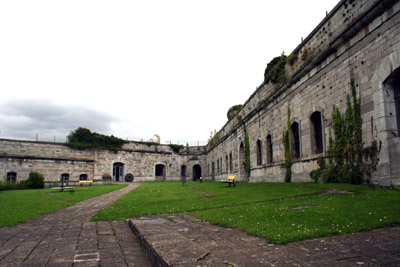 |
Fort de Huy
Huy, Belgium
|
|
 |
Constructed: 1815 - 1818
Used by: Holland, Belgium, Germany
Conflicts in which it participated:
First & Second World War
|
The city of Huy is just twelve miles down the Meuse River from Liège. Liège has been a big-deal city since the Middle Ages, and Huy has always been its smaller, unfortunate cousin. At the very least Huy has served as an early-warning system for Liège...the smaller town is upriver from the larger, so any riverborne invasion force would have to lay waste to poor little Huy before they got to Liège. Notionally, the glow from a great piles of burning corpses in Huy would appear on the western horizon, and Liège would go, "huh, guess we should close the gates."
|
 |
|
|
Huy was one of the most prosperous towns on the Meuse by the early Middle Ages, and its signature structure was Li Tchestia, a monst'rous castle built by the Princes of Liège. These princes must have sucked at princing, because they used Li Tchestia as a convenient, secure place at which to wait out the townspeople of Liège when they were angry over some insignificant thing or another.
|
| A cable system, by which visitors can ride in luxury over the Meuse River, Huy and the fortress, was installed in 1957. |
 |
Huy's cloth industry boomed through the 13th and 14th centuries. By the 17th century, however, French King Louis VIV (1638-1715)'s wars brought the French, Austrians and Dutch to the region, and Huy, with its big, inviting castle and strategic spot on the Meuse, was overrun on several occasions. The people of Huy dismantled Li Tchestia in 1715, as they considered it to be the cause of their miseries.
Austria came out of these wars as the rulers of much of Belgium. The First French Republic, led by Napoleon (1769-1821), then annexed this land in the early 1790's. |
|
Once Napoleon had been defeated in 1815, Belgium came under the control of the United Kingdom of the Netherlands, which essentially meant Holland was in charge of things. The Dutch decided that such a cool spot really did need a fortification of some kind, whether the townspeople like the idea or not. The current Fort de Huy was built, from 1815 to 1818, on the spot where Li Tchestia had stood.
Belgium declared independence from the United Kingdom of the Netherlands in 1831, and its independence was officially recognized in 1839.
|
The Fort de Huy was never used for its intended purpose, but as did so many starforts, served as a prison for a great many years. In March of 1848 a group of 2000 Belgian revolutionaries, put up to some degree by the French government, toppled over the border into the tiny hamlet of Risquons-all (Risk-all). In this tiny, unlikely place they began a bold campaign to free all of Belgium from the wicked yoke of the Belgian monarchy. They were met by about 250 Belgian infantry, who fired their carronades at the revolutionaries a few times, completely routing them and ending the insurrection less than two hours after it had started. Those revolutionaries who were captured were imprisoned at Fort de Huy.
|
 |
Fort de Huy's main gate. Those flower beds don't look particularly militaristic, do they? |
|
In 1876 the town of Huy sold their fort to the Belgian government. In early 1914 attempts were made to further fortify the Meuse River, which included some improvements to the fort or our current interest. Germany crashed over the border in August of 1914, as the opening act of the First World War (1914-1918), and whatever improvements that had been made to the Fort de Huy or the rest of the Meuse didn't seem to hinder the wicked hun all that much. The fort was used as an internal discipline camp by the Germans.
|

The Fort du Huy looks like a relatively small starfort. It never actually defended anything from anybody, but it served as an excellent place for Germans to make Belgians suffer! |
 |
The Germans who returned to Huy in 1940 during the Second World War (1939-1945) obviously had fond institutional memories of the Fort de Huy, because they gleefully resumed residence therein. The fort was smashingly successful not only as a harsh prison camp, but also as a "sorting center," at which candidates for the death camps were separated from those who only needed to be beaten and starved and stuff. Kind of difficult to make hilarious jokes about Nazi concentration camps.
In 1992 a museum dedicated to the Belgian Resistance and telling the story of the concentration camps was established at the Fort de Huy. |
|
In 1957, a cable system was strung over the Meuse for passengers to ride around in gondolas: A trestle was mounted at the fort. The cable was duly severed by a helicopter in 2012. Accident? Perhaps.
|
|
|
|
|
|
 |


